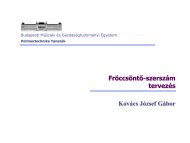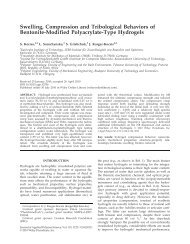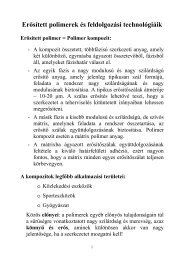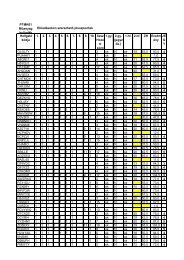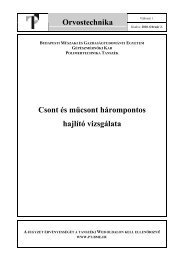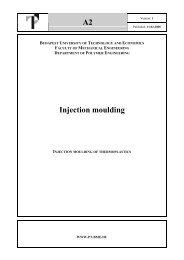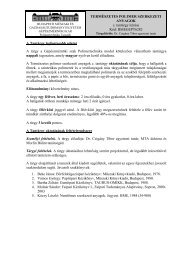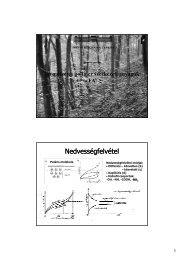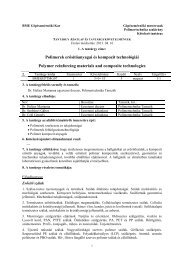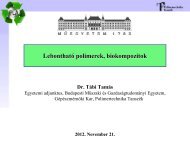Hybrid thermosets from polyisocyanate/water glass/emulsifier ...
Hybrid thermosets from polyisocyanate/water glass/emulsifier ...
Hybrid thermosets from polyisocyanate/water glass/emulsifier ...
Create successful ePaper yourself
Turn your PDF publications into a flip-book with our unique Google optimized e-Paper software.
<strong>Hybrid</strong> Thermosets <strong>from</strong> Polyisocyanate/<br />
Water Glass/Emulsifier Systems: Effects of<br />
Melamine-Formaldehyde Resin<br />
Núria Castellà, 1 Sergiy Grishchuk, 1 Jozsef Karger-Kocsis, 2,3 Martin Schehl 1<br />
1 Institut für Verbundwerkstoffe GmbH (Institute for Composite Materials), Kaiserslautern University of Technology,<br />
D-67663 Kaiserslautern, Germany<br />
2 Faculty of Mechanical Engineering, Department of Polymer Engineering, Budapest, University of Technology and<br />
Economics, H-1111 Budapest, Hungary<br />
2 Polymer Technology, Faculty of Engineering and Built Environment, Tshwane University of Technology,<br />
Pretoria 0001, South Africa<br />
Received 30 March 2009; accepted 16 May 2009<br />
DOI 10.1002/app.30780<br />
Published online 20 July 2010 in Wiley Online Library (wileyonlinelibrary.com).<br />
ABSTRACT: Melamine-formaldehyde resin (MF) was<br />
selected as potential reactive <strong>emulsifier</strong> for polyurea-based<br />
thermoset resins produced <strong>from</strong> <strong>polyisocyanate</strong>/<strong>water</strong><br />
<strong>glass</strong> (WG)/<strong>emulsifier</strong> systems. As <strong>emulsifier</strong> tricresylphosphate<br />
and/or MF served for the initial <strong>water</strong>-in-oil<br />
type (‘‘<strong>water</strong>’’ ¼ WG; ‘‘oil’’ ¼ <strong>polyisocyanate</strong> þ <strong>emulsifier</strong>)<br />
emulsions. The MF content of the systems has been varied<br />
(15 wt %) and its effect on the structure, mechanical,<br />
thermal and flammability properties of the final polyureabased<br />
<strong>thermosets</strong> studied. It was found that MF is a suitable<br />
<strong>emulsifier</strong>, which can fully replace the phosphate without<br />
negatively affecting the properties of the resulting<br />
hybrid <strong>thermosets</strong>. Moreover, hybridization with MF was<br />
often accompanied with pronounced improvements in<br />
fracture mechanical and static flexural properties. VC 2010<br />
Wiley Periodicals, Inc. J Appl Polym Sci 119: 7–14, 2011<br />
Key words: thermosetting hybrid resins; dispersions;<br />
particle size distribution; flame retardance; structureproperty<br />
relations<br />
INTRODUCTION<br />
Polyisocyanates are highly reactive components<br />
which may enter in different reactions resulting in<br />
linear and crosslinked polymers, such as polyurethanes,<br />
polyisocyanurates, and polyureas. The latter<br />
compounds form by reactions between ANCO and<br />
ANH 2 groups. Primary amines can be produced via<br />
the reaction –NCO þ H 2 O ! NH 2 þ CO 2 <strong>from</strong><br />
<strong>polyisocyanate</strong>s, as well. This reaction is taking place<br />
in presence of aqueous media, like <strong>water</strong> <strong>glass</strong><br />
(WG). Accordingly, WG is an interesting reactant in<br />
the <strong>polyisocyanate</strong> chemistry. 1–5 Note that WG is a<br />
mixture of salts (usually sodium or potassium) of<br />
polysilicic acids.<br />
WG, when dispersed in <strong>polyisocyanate</strong>s with a<br />
functionality of higher than 2, yields highly reactive<br />
<strong>water</strong> in oil type emulsion (W/O). This cures very<br />
fast into a polyurea-based thermoset. The rapid reaction<br />
between the <strong>water</strong> and the isocyanate can<br />
Correspondence to: S. Grishchuk (sergiy.gryshchuk@ivw.<br />
uni-kl.de).<br />
Contract grant sponsor: German Research Foundation;<br />
contract grant number: Ka 1202/15.<br />
Journal of Applied Polymer Science, Vol. 119, 7–14 (2011)<br />
VC 2010 Wiley Periodicals, Inc.<br />
hardly be controlled unless a suitable <strong>emulsifier</strong> is<br />
used. Commercially available systems, as 3P resins<br />
of Polinvent Ltd, Budapest, Hungary, contain phosphates<br />
as <strong>emulsifier</strong>s and thus ‘‘reaction controllers’’.<br />
6 Note that the designation of 3P is derived<br />
<strong>from</strong> the related composition: <strong>polyisocyanate</strong>, phosphate<br />
and polysilicate. ‘‘Polysilicate’’ is formed by<br />
hardening (silicification) of WG. The related resins<br />
are gaining acceptance in repair of pipes (canalization)<br />
and strengthening of walls (mining industry,<br />
tunnels). Such applications are favoured by the fact<br />
that 3P resins cure also in and under <strong>water</strong>.<br />
Attempts were already made to improve the thermal,<br />
mechanical and fracture mechanical properties<br />
of the corresponding polyurea based <strong>thermosets</strong>.<br />
‘‘Nanomodification’’ by incorporating nanoscaled<br />
<strong>water</strong> dispersible alumina proved to be less promising<br />
7 than the hybridization concept targeting the<br />
polyurea-type matrix. 8–10<br />
The presence of phosphate is a problematic issue<br />
in the 3P systems due to its diffusion, ‘‘leakage’’.<br />
Following the European Community Regulation on<br />
chemicals and their safe use registration, evaluation,<br />
authorization and restriction of chemical substances<br />
(REACH) (EC 1907/2006), 11 which calls for the progressive<br />
substitution of the most dangerous chemicals<br />
when suitable alternatives have been identified,
8 CASTELLÀ ET AL.<br />
vivid search started to find suitable <strong>emulsifier</strong>s for<br />
the <strong>polyisocyanate</strong>/WG systems. Our intention was<br />
to replace or at least reduce the amount of the<br />
present organic phosphate being not environmental<br />
benign. The new <strong>emulsifier</strong>s should be coreactive,<br />
prolong the pot life of the hybrid systems and<br />
enhance or maintain their properties. Accordingly,<br />
the present work was focused on the application of<br />
<strong>emulsifier</strong>s of coreactive nature for the <strong>polyisocyanate</strong>/WG<br />
systems. ‘‘Reactive’’ means that the related<br />
<strong>emulsifier</strong>s should be chemically built in the final<br />
cross-linked structure.<br />
For that purpose, we have selected <strong>water</strong>-free<br />
melamine-formaldehyde resin (MF) which is resistant<br />
to strong alkalis (like WG) and via its methylol<br />
groups reactive towards the ANCO groups of the<br />
<strong>polyisocyanate</strong>. So the aim of this contribution was<br />
to check whether MF can replace phosphate and<br />
thus overtake the role of an ‘‘active <strong>emulsifier</strong>’’ in 3P<br />
systems. A further aim of this work was to determine<br />
whether the incorporation of MF is accompanied<br />
with improvement with respect to the mechanical<br />
and thermal properties of the corresponding hybrid<br />
resins.<br />
Due to the poor solubility of MF in aqueous media<br />
attempts were made to replace the phosphate <strong>emulsifier</strong><br />
completely by MF. The related resins are termed<br />
2P resins (<strong>from</strong> <strong>polyisocyanate</strong> and polysilicate).<br />
When MF is dispersed in isocyanate, the hydroxyls<br />
<strong>from</strong> the methylolated melamine react with<br />
isocyanates to produce urethane crosslinking sites<br />
between the final polyurea and MF.<br />
Among other possible, but less probable reactions,<br />
the reaction between the amines (formed thanks to<br />
the reaction of isocyanates with WG) with the<br />
hydroxyls of the methylolated melamine is noteworthy.<br />
12–15 However, this reaction is practically inexistent<br />
since first, the majority of the amine formed will<br />
react with isocyanates to form the polyurea matrix,<br />
and second, the MF crosslinking reaction according<br />
to Scheme 2 is negligible at room temperature (while<br />
it increases exponentially with temperatures above<br />
100 C). Therefore, the crosslinking via amines occurs<br />
mainly during curing of the resin. 16–21<br />
EXPERIMENTAL<br />
Materials<br />
The silicate source (Inosil Na-5120 <strong>water</strong><strong>glass</strong> (WG)<br />
of sodium silicate type) was donated by ASAG<br />
Umwelttechnik (Neukirchen-Vluyn, Deutschland).<br />
This WG had a ‘‘modulus’’, i.e. SiO 2 /Na 2 O ¼ 2.02 <br />
0.02, and a viscosity: 600 100 mPas ambient temperature.<br />
As <strong>polyisocyanate</strong> source 4,4 0 -diphenylmethane<br />
diisocyanate (PMDI) was used. Ongronat VR<br />
CR-<br />
30-60 PMDI was purchased <strong>from</strong> Borsodchem Rt<br />
(Kazincbarcika, Hungary) and showed the following<br />
characteristics: NCO content 30–31.5 wt %, viscosity:<br />
520–680 mPa s, acidity max. 0.05 wt % and a density<br />
of 1.23 g/mL. For the PMDI/WG system tricresylphosphate<br />
(TCP) (Disflamoll TCP, Lanxess Deutschland<br />
GmbH, Leverkusen, Germany) was used as an<br />
<strong>emulsifier</strong>; phosphorous content: 8.4 wt %; density:<br />
1.18 g/mL at 20 C; viscosity: 69 mPa s at 20 C. MF<br />
(HIPE VR ESIN MF 100C) was purchased <strong>from</strong> Agrolinz<br />
Melamine International Italia S.r.l (Castellanza,<br />
Italy). This MF was a white powder of 0.6 kg/<br />
dm 3 bulk density and with less than 2.0 wt % of volatile<br />
content. Note that MF is soluble at room temperature<br />
in <strong>water</strong> and <strong>water</strong>/alcohol mixtures.<br />
Sample preparation<br />
The 3P/MF hybrid resins were prepared first by<br />
homogenising the TCP and the PMDI for 1 min at<br />
1400 rpm with a cogged-wheel-mixer. Subsequently<br />
MF was dispersed in the PMDI/TCP mixture for<br />
1 min at 2000 rpm with the same mixer and<br />
degassed under vacuum. WG was added and dispersed<br />
in the final system for 1 min at 800 rpm with<br />
the mixer. The MF content in the 3P resins was varied,<br />
viz. MF was applied in 15, 10, 5, 2.5, 1, 0.5 wt %<br />
MF considering the total resin content.<br />
Attempts were also made to fully replace the TCP<br />
in the recipe. The corresponding systems were<br />
termed to 2P resins (<strong>from</strong> <strong>polyisocyanate</strong> and polysilicate).<br />
The 2P/MF hybrid resins were produced as<br />
follows: different amounts of MF (0.5,1, 2.5, 5, 10,<br />
and 15 wt % of the total sample weight) were dispersed<br />
in PMDI with a cogged-wheel mixer for<br />
1 min at 2000 rpm and then the air bubbles were<br />
removed under vacuum. Afterwards WG was added<br />
and dispersed for 1 min at 800 rpm.<br />
The resulting mixtures, 3P/MF and 2P/MF, were<br />
both degassed in vacuum. Their curing regime was<br />
20 h at RT and 4 h at 100 C.<br />
Tests<br />
The mean particle size and size distribution of the silicate<br />
particles were determined using scanning electron<br />
microscope (SEM) images (JSM 5400 device of<br />
Jeol, Tokyo, Japan). They were taken <strong>from</strong> the surface<br />
of broken compact tension (CT) specimens. The surface<br />
was coated with an Au–Pd alloy before SEM<br />
investigation. SEM pictures of minimum three showing<br />
more than 100 particles were taken into consideration<br />
when determining the particle size distribution.<br />
The latter was quantified by the mean number d n and<br />
weight average d w particle diameter respectively.<br />
The fracture toughness (K c ) and fracture energy<br />
(G c ) were measured according to ISO 13586-1 standard.<br />
The tests were done with a Zwick universal<br />
Journal of Applied Polymer Science DOI 10.1002/app
HYBRID THERMOSETS 9<br />
Figure 1 SEM pictures <strong>from</strong> the broken surfaces of the reference 3P resin (a), 3P/MF-1% hybrid resin (b), 3P/MF-5%<br />
hybrid resin (c), 3P/MF-10% hybrid resin (d).<br />
testing machine type 1445 (Ulm, Germany) at room<br />
temperature with a crosshead speed of v ¼ 1 mm/<br />
min. The CT specimens (dimension: 35 35 <br />
3mm 3 ; length width thickness) were notched<br />
before loading by sawing. The sawn notch of the CT<br />
specimens was sharpened by a razor blade. The razor<br />
blade, fixed in a rig, was positioned in the notch<br />
root before hitting the fixing rig with a hammer.<br />
This yielded the desired sharp crack.<br />
The flexural properties, namely, modulus and<br />
strength of the hybrid resins, were determined on<br />
rectangular specimens (60 10 3mm 3 ; length <br />
width thickness) in three point bending at room<br />
temperature according to EN63. The span length of<br />
the specimens was 50 mm and their loading<br />
occurred with deformation rate v ¼ 1 mm/min.<br />
Dynamic mechanical thermal analysis (DMTA)<br />
were taken on rectangular specimens (60 10 <br />
3 mm, length width thickness) in three point<br />
bending configuration (span length: 50 mm) at 1 Hz<br />
using a DMA Q800 of TA Instruments (New Castle,<br />
DE). Tests were performed under displacement control<br />
using sinusoidal oscillation and under dynamic<br />
conditions in the interval T ¼þ25 C...þ250 Cata<br />
heating rate of 1 Cmin 1 .<br />
The resins were subjected to thermogravimetric<br />
analysis (TGA) in a TG50 device of Mettler Toledo<br />
(Giessen, Germany). The TGA experiments were conducted<br />
under nitrogen atmosphere in the temperature<br />
range T ¼ 25 C...þ600 C with heating rate 20 C/min.<br />
To test the flammability of the materials the UL<br />
94, Tests for Flammability of Plastic Materials for<br />
Parts in Devices and Appliances, was used. This test<br />
covers several types of testing: for our purpose, 94V<br />
flammability vertical test was chosen being a stringent<br />
test. In the 94V flammability test a specimen<br />
is supported in a vertical position and a flame is<br />
applied to the bottom of the specimen. The flame is<br />
applied for 10 s and then removed until flaming<br />
stops at which time the flame is reapplied for<br />
another 10 s and then removed. Three specimens for<br />
each material were tested.<br />
RESULTS AND DISCUSSION<br />
Polysilicate dispersion<br />
3P/MF<br />
The morphology of the 3P/MF hybrid systems, studied<br />
<strong>from</strong> the SEM pictures of the fracture surfaces<br />
(cf. Fig. 1), reveal no apparently influence of the MF.<br />
TABLE I<br />
Number- (d n ) and Weight-Average (d w ) Mean Particle<br />
Size of the 3P Reference and 3P/MF <strong>Hybrid</strong> Systems<br />
MF wt % 0 (3P) 0.5 1 2.5 5 10 15<br />
d n (lm) 11.2 12.7 10.9 11.2 11.0 9.7 7.5<br />
d w (lm) 15.5 17.9 13.8 16.1 15.9 12.7 10.7<br />
d w /d n 1.4 1.4 1.3 1.4 1.5 1.3 1.4<br />
Journal of Applied Polymer Science DOI 10.1002/app
10 CASTELLÀ ET AL.<br />
Figure 2 SEM pictures taken <strong>from</strong> the fracture surfaces of the 3P resin sample (a), 2P/MF-1% hybrid resin (b), 2P/MF-<br />
5% hybrid systems (c), 2P/MF-10% hybrid systems (d).<br />
Considering the morphology of the reference 3P and<br />
those of the 3P/MF hybrids, one can see that neither<br />
the particles size nor the distribution of the polysilicate<br />
particles altered by the hybridization of the initial<br />
3P resin with MF. However, when inspecting<br />
more accurately, one can observe that increasing MF<br />
contents reduce slightly the mean particle size diameter<br />
and that the 3P/MF hybrids as well as, the reference<br />
resin 3P, possess similar broad particle<br />
distributions (cf. Table I). Table I indicates that the<br />
amount of MF in the hybrid resins had little influence<br />
on the polysilicate particle distribution.<br />
substantially the particle size of the polysilicate in<br />
comparison with the reference 3P resins. The reference<br />
3P resin had an average particle size diameter<br />
of 10 lm, while for the 2P/MF hybrid systems this<br />
was reduced to its half, however, with some exceptions<br />
(cf. Table II). Moreover, the substitution of the<br />
phosphate by MF did not broaden the polysilicate<br />
distribution.<br />
Attention should be paid to the fact that the system<br />
2P/MF-10% owes a very small particle size and<br />
a narrower distribution compared to the other<br />
hybrids. This is well reflected in Figure 2d.<br />
2P/MF<br />
The SEM pictures obtained <strong>from</strong> the broken surface<br />
of the 2P/MF systems are presented in Figure 2. The<br />
substitution of the phosphate by the MF reduced<br />
TABLE II<br />
Number- (d n ) and Weight-Average Diameter (d w )<br />
of the Polysilicate Particles in the 3P Reference<br />
and 2P/MF <strong>Hybrid</strong> Systems<br />
MF wt % 0 (3P) 0.5 1 2.5 5 10 15<br />
d n (lm) 11.2 3.9 4.0 4.7 3.9 2.6 6.2<br />
d w (lm) 15.5 5.5 5.6 7.2 5.3 2.7 8.8<br />
d w /d n 1.4 1.4 1.4 1.5 1.3 1.1 1.4 Figure 3 DMTA results displaying E 0 vs. T for the 3P reference<br />
and 3P/MF hybrids.<br />
Journal of Applied Polymer Science DOI 10.1002/app
HYBRID THERMOSETS 11<br />
Figure 4 DMTA results displaying tan d vs. T for the 3P<br />
reference and 3P/MF hybrids.<br />
DMTA response, phase structure<br />
The DMTA tests results in form of storage modulus<br />
vs. Temperature (E 0 vs. T) traces are given in Figure 3<br />
for the 3P and the 3P/MF hybrid resins. The storage<br />
modulus (E 0 ) is mostly improved by the addition of<br />
MF in the systems, however only at room temperature.<br />
At higher temperatures the reference 3P resin<br />
exhibits higher stiffness than the 3P/MF versions. At<br />
temperatures around 150 C the 3P/MF specimens<br />
undergo a brusque discontinuity caused by premature<br />
failure. For the reference 3P resins such failure<br />
takes place at temperatures above 180 C.<br />
Inspecting the mechanical loss factor (tan d) vs. T<br />
traces for the reference 3P and its 3P/MF hybrids<br />
depicted in Figure 4, one can observe that the 3P/<br />
MF hybrid resins present two broad ’’shoulders’’ in<br />
the tan d traces at temperatures <strong>from</strong> 50 to 100 C<br />
and a second one <strong>from</strong> 130 to 160 C. Further, a not<br />
well resolved relaxation peak is also observed at<br />
temperatures <strong>from</strong> 180 to 210 C. Unfortunately, the<br />
premature failure of the specimens at T > 150 C<br />
hampers its detection.<br />
Figure 6 DMTA results displaying tan d vs. T for the 3P<br />
reference and 2P/MF hybrids.<br />
The DMTA traces in form of E 0 vs. T for the 3P<br />
and the 2P/MF hybrid resins are depicted in Figure<br />
5. The stiffness (E 0 ) increases with increasing MF<br />
content in the systems and it was higher than that of<br />
the 3P resin. One can recognise an abrupt discontinuity<br />
in the E 0 traces at T around 180 C for the 2P/<br />
MF systems as well as for the 3P reference resin due<br />
to the failure onset in the specimens at high<br />
temperatures.<br />
In the tan d vs. T traces, depicted in Figure 6, one<br />
can not clearly discern the <strong>glass</strong> transition temperature<br />
(T g ), when assigned to the highest peak temperature<br />
of the tan d vs. T traces. However, despite of<br />
the premature failure, the 2P/MF-0.5% and 2P/MF-<br />
5% hybrid resins show a reasonably definite peak at<br />
temperatures ranging <strong>from</strong> 200 to 250 C and a second<br />
broad and less resolved peak of low intensity<br />
centred at T 175 C. For the other hybrids, containing<br />
larger amounts of MF, the tan d peak at high<br />
temperatures is not well resolved.<br />
Flexural and fracture mechanical properties<br />
3P/MF—mechanical properties<br />
The fracture energy (G c ) and fracture toughness (K c )<br />
for the 3P/MF hybrid resins are summarized in Table<br />
III The hybridization of the 3P resins with MF<br />
TABLE III<br />
Fracture Toughness (K c ) and Fracture Energy (G c )<br />
for the 3P Reference and 3P/MF <strong>Hybrid</strong>s<br />
K c<br />
(MPa m 1/2 )<br />
s<br />
(MPa m 1/2 )<br />
G c<br />
(kJ m 2 )<br />
s<br />
(kJ m 2 )<br />
Figure 5 DMTA results displaying E 0 vs. T for the 3P reference<br />
and 2P/MF hybrids.<br />
3P 0.83 0.04 0.89 0.04<br />
3P/MF-0.5% 0.91 0.04 1.26 0.09<br />
3P/MF-1% 0.89 0.02 1.36 0.06<br />
3P/MF-2.5% 0.90 0.02 1.18 0.03<br />
3P/MF-5% 0.97 0.02 0.99 0.04<br />
3P/MF-10% 0.87 0.02 0.83 0.05<br />
3P/MF-15% 0.85 0.02 0.72 0.03<br />
s represents the standard deviation.<br />
Journal of Applied Polymer Science DOI 10.1002/app
12 CASTELLÀ ET AL.<br />
TABLE V<br />
Effects of the Compositional Changes on the Fracture<br />
Toughness (K c ) and Fracture Energy (G c ) for 2P/MF<br />
<strong>Hybrid</strong>s in Comparison with 3P Reference (cf. Table III)<br />
K c<br />
(MPa m 1/2 )<br />
s<br />
(MPa m 1/2 )<br />
G c<br />
(kJ m 2 )<br />
s<br />
(kJ m 2 )<br />
Figure 7 Changes in the flexural modulus as a function<br />
of the MF content for the 3P based systems.<br />
did have an effect on the fracture properties. Beholding<br />
the changes of the fracture properties for the<br />
hybrids with different MF content, one can see that<br />
the fracture energy of the hybrids is improved in<br />
relation to the reference. A G c increase was found<br />
for all the hybrids up to an MF content threshold of<br />
10 wt % MF, where G c is slightly lower than the reference<br />
3P afterwards. It is noteworthy that G c<br />
decreases with the MF content of the hybrid resins.<br />
This could be related to the diminished polysilicate<br />
particle size (cf. Table I) with increasing MF content<br />
which affects the failure mode. On the other hand,<br />
K c does not appear to be influenced by the hybridization<br />
with MF or by its amount. However, in general<br />
the fracture properties of the novel hybrid<br />
resins experienced a modest improvement.<br />
The flexural properties of the 3P/MF hybrid resins<br />
were positively influenced by the incorporation of<br />
MF (cf. Figure 7). Satisfactory results on the flexural<br />
properties were obtained <strong>from</strong> the hybridization of<br />
the 3P resins with MF. Increasing amounts of MF<br />
improve markedly the flexural modulus (E f ). In general,<br />
the increase of E f is parallel to the increase in<br />
MF. The strength passed a maximum whereas the<br />
flexural strain decreased as a function of MF wt.-%<br />
content (cf. Table IV).<br />
TABLE IV<br />
Flexural Modulus (E f ), Strength (r fm ), Strain (e m )<br />
and Standard Deviation (s) for the 3P Reference<br />
and 3P/MF <strong>Hybrid</strong>s<br />
E f<br />
(MPa)<br />
s<br />
(MPa)<br />
r fm<br />
(MPa)<br />
s<br />
(MPa)<br />
e M<br />
(%)<br />
s<br />
(%)<br />
3P 1047 56 34.6 3.9 4.4 0.9<br />
3P/MF-0.5% 1335 107 37.0 2.4 3.8 0.1<br />
3P/MF-1% 1383 87 37.4 1.8 3.5 0.2<br />
3P/MF-2.5% 1349 58 31.6 7.9 2.7 0.7<br />
3P/MF-5% 1424 94 34.6 4.7 2.9 0.4<br />
3P/MF-10% 1833 100 37.8 3.7 2.5 0.3<br />
3P/MF-15% 1891 173 35.9 2.9 2.4 1.0<br />
3P 0.97 0.06 1.10 0.09<br />
2P/MF-0.5% 0.81 0.03 0.93 0.06<br />
2P/MF-1% 0.83 0.02 0.85 0.06<br />
2P/MF-2.5% 0.82 0.01 0.75 0.04<br />
2P/MF-5% 0.91 0.03 0.80 0.07<br />
2P/MF-10% 0.84 0.03 0.60 0.02<br />
2P/MF-15% 0.97 0.06 1.10 0.09<br />
2P/MF—mechanical properties<br />
The results of the fracture tests carried out on the<br />
2P/MF hybrid resins are summarized in Table V.<br />
According to the results obtained, the substitution of<br />
the phosphate by the MF improved the fracture<br />
energy (G c ) of the hybrids only for MF contents<br />
lower than 2.5 wt %. With increasing MF amount in<br />
the hybrid systems G c decreased. On the other hand,<br />
the fracture toughness (K c ) was only slightly influenced<br />
by the amount of MF introduced. It is the<br />
right place to remark that, the system 2P/MF-10%<br />
gave comparable K c and G c results with the 3P<br />
reference.<br />
The flexural properties of the 2P/MF hybrids presented<br />
in Table VI reflect how the replacement of<br />
the phosphate by MF improves the stiffness of the<br />
systems in comparison to the 3P reference resin. The<br />
flexural modulus E f and strength (r fm ) increase with<br />
increasing MF content, however, at expenses of the<br />
flexural strain (e M ). This is comprehensible since<br />
larger amounts of MF confer higher rigidity to the<br />
samples and therefore they undergo smaller deformation<br />
at a given loading.<br />
Thermal and flame resistance behaviour<br />
3P/MF—thermal properties<br />
The thermal degradation behaviour of the 3P/MF<br />
hybrid resins, as well as their reference 3P, is shown<br />
TABLE VI<br />
Flexural Modulus (E f ), Strength (r fm ) and Strain (e m ) for<br />
the 3P Reference and 2P/MF <strong>Hybrid</strong> Resins<br />
(cf. Table III)<br />
E f<br />
(MPa)<br />
s<br />
(MPa)<br />
r fm<br />
(MPa)<br />
s<br />
(MPa)<br />
e M<br />
(%)<br />
s<br />
(%)<br />
3P 1047 56 34.6 3.9 4.4 0.9<br />
2P/MF-0.5% 1463 147 40.5 1.4 4.2 0.1<br />
2P/MF-1% 1375 95 37.4 1.9 3.5 0.3<br />
2P/MF-2.5% 1661 133 40.3 2.5 3.1 0.4<br />
2P/MF-5% 1618 174 44.2 3.9 3.3 0.2<br />
2P/MF-10% 2029 147 47.9 2.3 2.9 0.2<br />
2P/MF-15% 2085 113 51.8 5.3 2.9 0.3<br />
Journal of Applied Polymer Science DOI 10.1002/app
HYBRID THERMOSETS 13<br />
Figure 8 Mass loss vs. T for the 3P reference and 3P/MF<br />
hybrid resins.<br />
Figure 9 Mass loss vs. T for the 3P reference and 2P/MF<br />
hybrid resins.<br />
in Figure 8. When comparing the TG traces of the<br />
hybrids with that of the 3P reference, one can<br />
observe that the degradation steps for both resemble<br />
to one another, at least, <strong>from</strong> RT to 400 C. However,<br />
the degradation processes of the hybrids 3P/MF<br />
take place in general at higher temperatures. At temperatures<br />
above 400 C the reference 3P undergoes a<br />
considerable mass loss, while the 3P/MF hybrids<br />
continue to lose mass at a moderate rate. 22<br />
Observing more accurately the temperature at<br />
which the 5% of the mass is lost (T 5% ), one can<br />
clearly see that this ranges <strong>from</strong> 145 to 180 C for the<br />
corresponding 3P/MF hybrids, while for the 3P reference<br />
the 5% of the mass is lost at the early temperature<br />
of 125 C (cf. Table VII). Similarly, the residue<br />
remaining after the degradation process is significantly<br />
higher for the 3P/MF hybrids, increasing<br />
along with the MF content, than for the reference 3P,<br />
which is approximately a 23% of the initial specimen<br />
mass. To sum up we can assert that the hybridization<br />
of the 3P resins with MF had a positive influence<br />
on the thermal behaviour.<br />
The flammability test for the 3P/MF hybrid resins,<br />
according to the 94UL standards for vertical burn<br />
(94V), give a classification of is V-0. The total flaming<br />
combustion time was zero, the specimens did<br />
not burn with flaming combustion after the flame<br />
application and they did not drip flaming particles<br />
that ignite the cotton. The results obtained <strong>from</strong> the<br />
flammability test showed that 3P/MF hybrid resins<br />
are good fire resistant materials.<br />
2P/MF—thermal properties<br />
TGA curves depicted in Figure 9 show the thermal<br />
behaviour of the 2P/MF hybrids with different MF<br />
content. The response of the diverse hybrids seems<br />
not to be influenced by the MF content, since they do<br />
not differ one <strong>from</strong> another in a great extent, yet the<br />
2P/MF-10% system presents a markedly different<br />
behaviour (cf. Table VIII). The 2P/MF hybrid systems<br />
are stable at temperatures below 200 C, as seen<br />
before in the DMTA analysis, before they suffer a<br />
brusque loss of mass. Nonetheless, the continuous<br />
mass loss is not as severe as for the reference 3P,<br />
which at temperatures above 300 C exhibits a second<br />
remarkable mass loss. Therefore, the substitution of<br />
the phosphate by MF appears to influence positively<br />
the thermal resistance of the novel hybrids.<br />
The flammability tests, conducted on the 2P/MF<br />
hybrid resins, showed that the specimens did not<br />
burn with flaming combustion after the flame<br />
application as well as they did not burn with flaming<br />
or glowing combustion up to the specimen<br />
holding clamp. Moreover the 2P/MF resins did not<br />
produce flaming particles that ignite the cotton.<br />
The total flaming combustion time was zero or 1 s<br />
for some specimens; therefore the classification of<br />
TABLE VII<br />
T 5% ( C) and Residue (%) of the 3P/MF <strong>Hybrid</strong> Resins as<br />
a Function of Their MF Content<br />
MF (wt %) 0.5 1 2.5 5 10 15<br />
T 5% ( C) 167 145 170 178 169 163<br />
Residue (%) 37 39 41 43 43 43<br />
TABLE VIII<br />
T 5% ( C) and Residue (%) of the 2P/MF <strong>Hybrid</strong> Resins as<br />
a Function of their MF Content<br />
MF (wt %) 0.5 1 2.5 5 10 15<br />
T 5% ( C) 160 143 147 159 126 171<br />
Residue (%) 32 34 34 34 20 34<br />
Journal of Applied Polymer Science DOI 10.1002/app
14 CASTELLÀ ET AL.<br />
the 2P/MF resins according to the 94UL standards<br />
is V-0. The results obtained <strong>from</strong> the flammability<br />
test showed that 2P/MF resins are good fire resistant<br />
materials and that the substitution of the phosphate<br />
(which is an active flame retardant additive)<br />
by MF resin is straightforward also in terms of fire<br />
resistance.<br />
CONCLUSION<br />
This work was devoted to study the effect of MF as<br />
reactive <strong>emulsifier</strong> for <strong>polyisocyanate</strong>/polysilicate/<br />
phosphate (3P) and <strong>polyisocyanate</strong>/polysilicate (2P)<br />
resins. The polyurea-based 3P and 2P resins were produced<br />
<strong>from</strong> <strong>water</strong>-in-oil type emulsions composed of<br />
WG (‘‘<strong>water</strong>’’) and <strong>polyisocyanate</strong> þ <strong>emulsifier</strong> (‘‘oil’’).<br />
The results achieved can be summarized as follows:<br />
• Incorporation of MF in a reference 3P resins<br />
slightly reduced the mean particle size of the<br />
polysilicate derived <strong>from</strong> the WG. So, MF<br />
worked as additional <strong>emulsifier</strong> to phosphate in<br />
the reference 3P resin. MF fulfilled the role of<br />
<strong>emulsifier</strong> in 2P systems. This was confirmed by<br />
a pronounced reduction of the mean particle<br />
size of the polysilicate.<br />
• The fracture mechanical and static flexural properties<br />
of both 3P and 2P resins were mostly<br />
improved by MF hybridization. The change in<br />
the related properties as a function of MF was<br />
not always linear.<br />
• The thermal degradation was delayed; the char<br />
yielded increased with increasing MF content for<br />
the 3P/MF systems. This was less prominent for<br />
the 2P/MF companions. The flame resistance<br />
of the hybrids was not affected by MF incorporation.<br />
References<br />
1. Stoye, D., Ed. Paints, Coatings and Solvents; VCH: Weinheim,<br />
Germany, 1993; p 94.<br />
2. Mamunya, Ye. P.; Iurzhenko, M. V.; Lebedev, E. V.; Ischenko,<br />
S. S.; Boiteux, G.; Seytre, G. J Non-Crystalline Solids 2007, 535,<br />
4288.<br />
3. Mamunya, Ye. P.; Shtompel, V. I.; Lebedev, E. V.; Pissis, P.;<br />
Kanapitsas, A.; Boiteux, G. Eur Polym J 2004, 40, 2323.<br />
4. Pizzi, A.; Walton, T. Holzforschung 1992, 46, 541.<br />
5. Pizzi, A.; Valenzuela, J.; Westermeyer, C. Holzforschung 1993,<br />
47, 69.<br />
6. Erdélyi, S.; Karger-Kocsis, J.; Nagy, G. J Macromol Sci B 2007,<br />
46B, 21.<br />
7. Castellà, N.; Grishchuk, S.; Karger-Kocsis, J. Plast Rubber<br />
Compos 2007, 36, 122.<br />
8. Karger-Kocsis, J.; Erdélyi, S.; Nagy, G. J Appl Polym Sci 2007,<br />
103, 853.<br />
9. Grishchuk, S.; Castellà, N.; Karger-Kocsis, J. Eur Polym J 2007,<br />
43, 1245.<br />
10. Karger-Kocsis, J. Express Polym Lett 2007, 1, 122.<br />
11. REACH—European Community Regulation. Available at<br />
http://ec.europa.eu/environment/chemicals/reach/reach_<br />
intro.htm<br />
12. Wieland, S.; Pizzi, A.; Grigsby, W.; Warnes, J.; Pichelin, J.<br />
J Appl Polym Sci 2007, 104, 2633.<br />
13. Despres, A.; Pizzi, A.; Delmotte, L. J Appl Polym Sci 2006, 99,<br />
589.<br />
14. Simon, C.; George, B.; Pizzi, A. J Appl Polym Sci 2002, 86,<br />
3681.<br />
15. Wieland, S.; Pizzi, A.; Hill, S.; Grigsby, W.; Pichelin, J. J Appl<br />
Polym Sci 2006, 100, 624.<br />
16. Ege, S. Química Orgánica—Estructura y Reactividad. Editorial<br />
Reverte, 2000; Vol. 1–2.<br />
17. Stevens, M. P. Polymer Chemistry. An Introduction; Oxford<br />
University Press: New York-Oxford, 1990.<br />
18. Bauer, D. R. J Appl Polym Sci 1982, 27, 3651.<br />
19. Scheepers, M. L.; Gelan, J. M.; Carleer, R. A.; Adriaensens,<br />
P. J.; Vanderzande, D. J. Vib Spectrosc 1993, 6, 55.<br />
20. Wilson, R. C.; Pfohl, W. F. Vib Spectrosc 2000, 23, 13.<br />
21. Anderson, D. G.; Netzel, D. A.; Tessari, D. J. J Appl Polym Sci<br />
1970, 14, 3021.<br />
22. Costa, L.; Camino, G. J Therm Anal 1988, 34, 423.<br />
Journal of Applied Polymer Science DOI 10.1002/app




